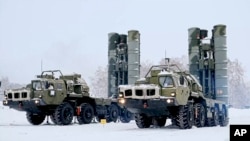The United States assesses that Russia is suffering failure rates as high as 60% on some days for some of the precision-guided missiles it is using to attack Ukraine, three U.S. officials with knowledge of the intelligence told Reuters.
The disclosure could help explain why Russia has failed to achieve what most could consider basic objectives since its invasion a month ago, such as neutralizing Ukraine's air force, despite the apparent strength of its military against Ukraine's much smaller armed forces.
The U.S. officials, who spoke on condition of anonymity because of the sensitivity of the information, did not provide evidence to support the assessment and did not disclose what precisely was driving high Russian missile failure rates.
Reuters was unable to independently verify the figures.
The Kremlin and Russia's defense ministry did not immediately respond to a request for comment.
Such a high failure rate can include anything from launch failures to a missile failing to explode on impact.
U.S. defense officials told reporters this week that the Pentagon assesses that Russia has launched more than 1,100 missiles of all kinds since the war began. The U.S. officials have so far not said how many of those hit their targets and how many failed to do so.
Citing U.S. intelligence, three U.S. officials said the United States estimated that Russia's failure rate varied day-to-day, depended on the type of missile being launched, and could sometimes exceed 50%. Two of them said it reached as high as 60%.
One of the officials said the intelligence showed that Russia's air-launched cruise missiles had a failure rate in the 20% to 60% range, depending on the day.
Russia has been seen fielding two types of air-launched cruise missiles in Ukraine, the Kh-555 and Kh-101, according to the Center for Strategic and International Studies think tank's Missile Defense Project.
Reuters could not determine what a standard failure rate would be for air-launched cruise missiles. Two experts interviewed by Reuters said any failure rate of 20% and above would be considered high.
The United States believes Russia fired air-launched cruise missiles from Russian airspace earlier this month when it attacked a Ukrainian military base near the Polish border, and one of the U.S. officials told Reuters there was a particularly high failure rate during this attack. The strike killed 35 people, according to Ukrainian authorities.
Missile attacks have been a feature of Russia's invasion, with Russia announcing strikes against military targets including weapons depots.
The invasion has killed thousands and driven a quarter of Ukraine's 44 million people from their homes. The bombardment has hit residential areas, schools and hospitals in Ukrainian cities, including Kharkiv and the besieged port of Mariupol on the Sea of Azov.
Russia, which says its military is engaged in a "special operation" in Ukraine, denies targeting civilians.




















